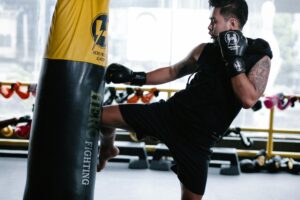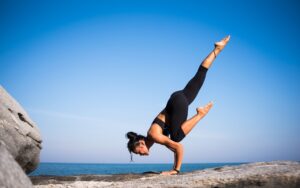Introduction
A great stance is fundamental for in general well-being and prosperity, yet many individuals go through hours every day slumped over PCs or cell phones, prompting unfortunate stances and related medical problems. Luckily, integrating explicit activities into your routine can assist with fortifying muscles, and further develop adaptability, and the right postural irregular characteristics. In this article, we’ll investigate 12 successful activities to improve your stance and advance ideal arrangements for better well-being. 12 Exercises to Improve Your Posture
1. Feline Cow Stretch

The feline cow stretch is a delicate yoga practice that works on spinal versatility and stance by extending and preparing the spine.
Instructions to Do It:
- Begin your hands and knees in a tabletop position, with your wrists adjusted under your shoulders and knees under your hips.
- Breathe in as you curve your back, lifting your chest and tailbone towards the roof (cow present).
- Breathe out as you round your spine, tucking your jawline towards your chest and squeezing through your hands and knees (feline posture).
- Rehash for 10-15 redundancies, moving with your breath.
2. Shoulder Bone Squeezes

Shoulder bone crushes assist with reinforcing the muscles of the upper back and further develop pose by advancing the legitimate arrangement of the shoulders. 12 Exercises to Improve Your Posture
Step-by-step instructions to Do It:
- Stand or sit with your arms loose at your sides and your spine tall.
- Delicately crush your shoulder bones together, drawing them towards your spine.
- Hold for 3-5 seconds, then, at that point, discharge.
- Rehash for 10-15 redundancies, zeroing in on keeping up with great stance all through.
3. Wall Angels
Wall holy messengers are an incredible activity for further developing stance by reinforcing the muscles of the upper back and shoulders while likewise extending the chest and shoulders. 12 Exercises to Improve Your Posture
Instructions to Do It:
- Stand with your back against a wall, feet hip-width separated, and knees somewhat twisted.
- Bring your arms up to bear level, elbows bowed at 90 degrees, and palms looking ahead, leaning against the wall.
- Gradually slide your arms up the wall, keeping your elbows and wrists in touch with the wall however much as could be expected.
- Stop when your arms are above, then, at that point, gradually lower them back down to the beginning position.
- Rehash for 10-15 redundancies, zeroing in on keeping in touch with the wall all through the development.
4. Thoracic Extension
Thoracic augmentation practices assist with balancing the impacts of drawn-out sitting and slumping by further developing portability in the upper back and opening up the chest.
The most effective method to Do It:
- Sit on the floor with your legs reached out before you and your hands behind your head, elbows calling attention to the sides.
- Connect with your center and gradually curve your upper back, lifting your chest towards the roof.
- Hold for 5-10 seconds, then return to the beginning position.
- Rehash for 10-15 reiterations, zeroing in on keeping a tall spine all through the development.
5. Inclined Y-T-W Exercises
Inclined Y-T-W practices focus on the muscles of the upper back and shoulders, assisting with reinforcing and settling the muscles that help great stance. 12 Exercises to Improve Your Posture
The most effective method to Do It:
- Lie face down on a mat with your arms expanded above, framing a Y shape with your body.
- Lift your arms off the ground, pressing your shoulder bones together as you lift.
- Hold for 2-3 seconds, then lower your arms down to the beginning position.
- Rehash for 10-15 redundancies, then, at that point, continue toward the T and W varieties, lifting your arms out to the sides and bowing your elbows at 90 degrees, separately.
6. Hip Flexor Stretch

Tight hip flexors can add to an unfortunate stance by hauling the pelvis lopsided. Extending the hip flexors can assist with further developing stance and reduce lower back torment.
Instructions to Do It:
- Bow on the ground with one knee twisted at 90 degrees before you and the other knee on the ground behind you.
- Draw in your center and delicately shift your weight forward, feeling a stretch toward the front of your hip on the leg with the knee twisted.
- Hold for 20-30 seconds, then switch sides and rehash.
7. Chest Opener Stretch
The chest opener stretch neutralizes the impacts of slumping and adjusted shoulders by extending the chest muscles and opening up the front of the body.
The most effective method to Do It:
- Stand tall with your feet hip-width separated and your arms reached out to the sides at shoulder level, palms looking ahead.
- Tenderly press your shoulder bones together as you arrive at your arms behind you, opening up your chest.
- Hold for 20-30 seconds, then discharge.
8. Jaw Tucks
Jaw tucks assist with reinforcing the muscles of the neck and upper back, advancing the appropriate arrangement of the head and neck, and lessening the burden on the cervical spine.
The most effective method to Do It:
- Sit or remain with your spine tall and shoulders loose.
- Tenderly fold your jaw towards your chest, protracting the rear of your neck.
- Hold for 5-10 seconds, then return to the beginning position.
- Rehash for 10-15 reiterations, zeroing in on keeping an impartial spine all through.
9. Situated Spinal Twist
The situated spinal contort is a yoga representation that works on spinal portability and adaptability, advancing great stance and arrangement.
The most effective method to Do It:
- Sit on the floor with your legs reached out before you.
- Twist your right knee and get it over your left leg, putting your right foot level on the floor.
- Put your left hand outwardly of your right knee and your right hand on the floor behind you.
- Delicately turn your middle to one side, investigating your right shoulder.
- Hold for 20-30 seconds, then switch sides and rehash.
10. Plank

The board is a full-body practice that fortifies the center, shoulders, and back muscles, advancing soundness and legitimate arrangement.
Step-by-step instructions to Do It:
- Fire in a push-up position, with your hands shoulder-width separated and your body in an orderly fashion from head to heels.
- Connect with your center and stand firm on this footing for 20-60 seconds, zeroing in on keeping an unbiased spine and abstaining from listing or curving.
- For a changed rendition, you can play out the board on your lower arms rather than your hands.









